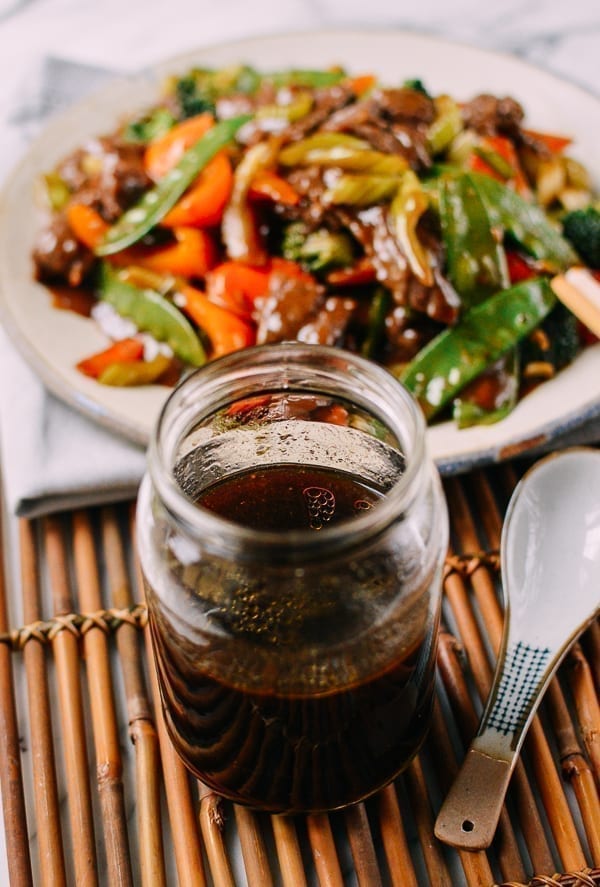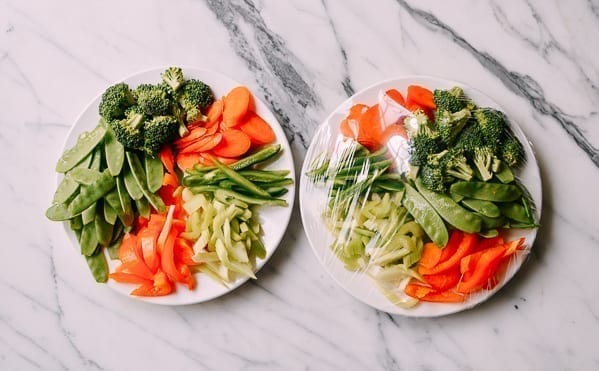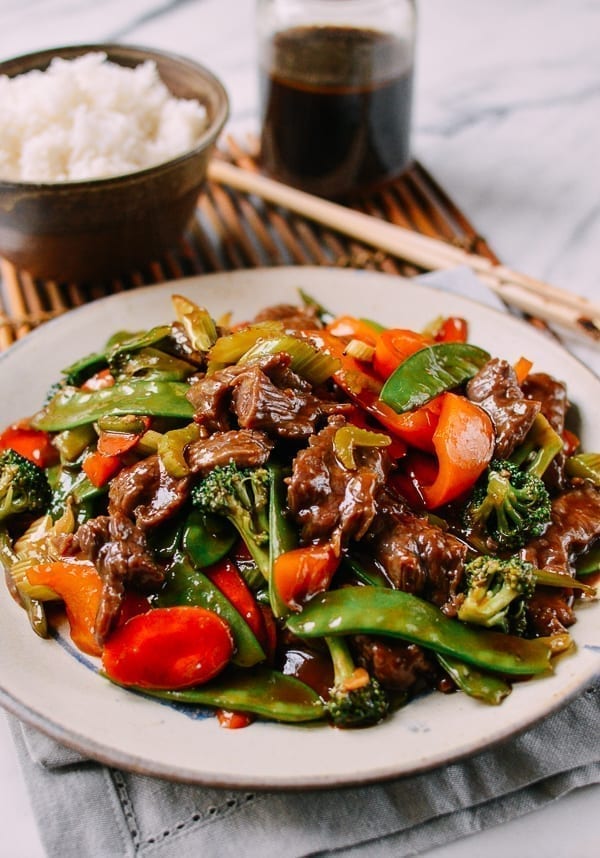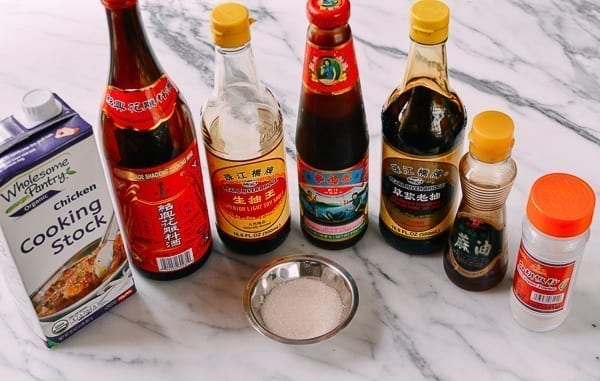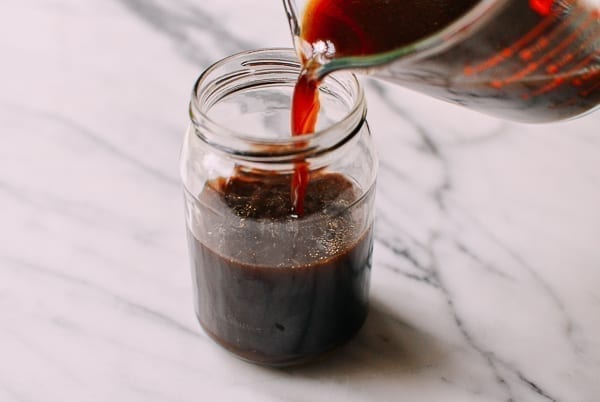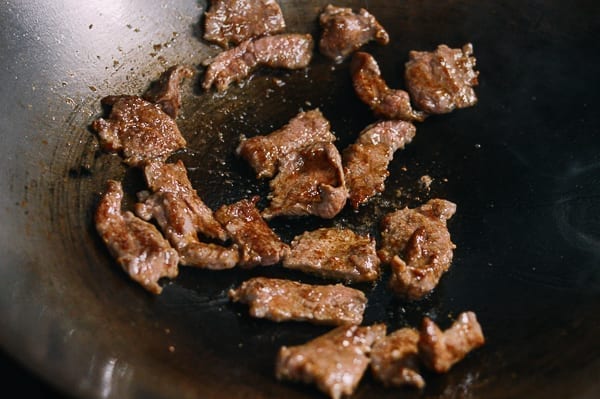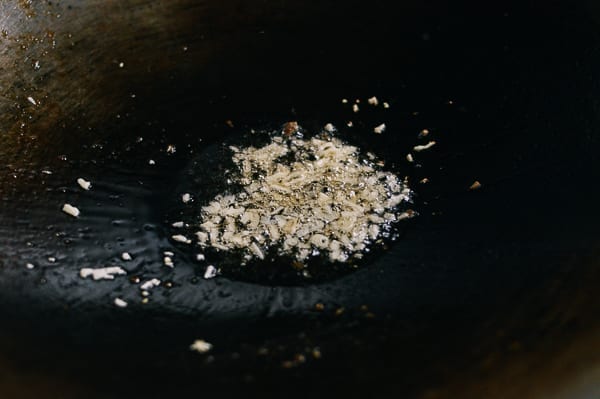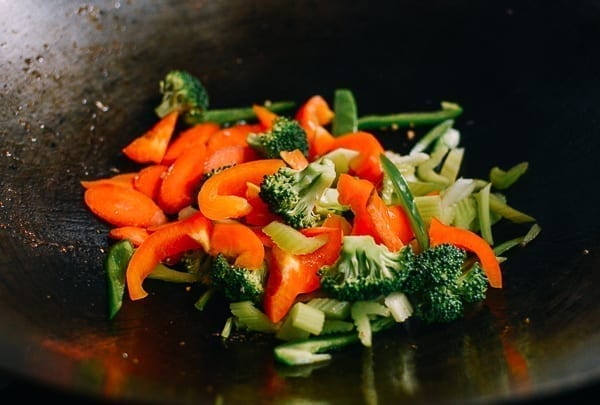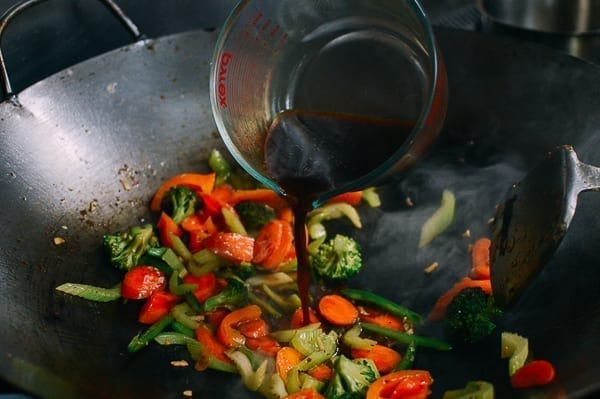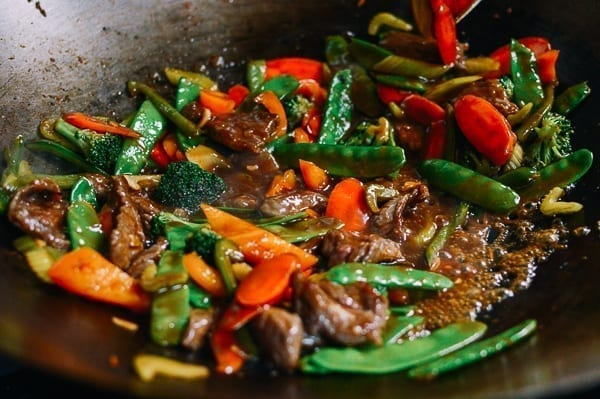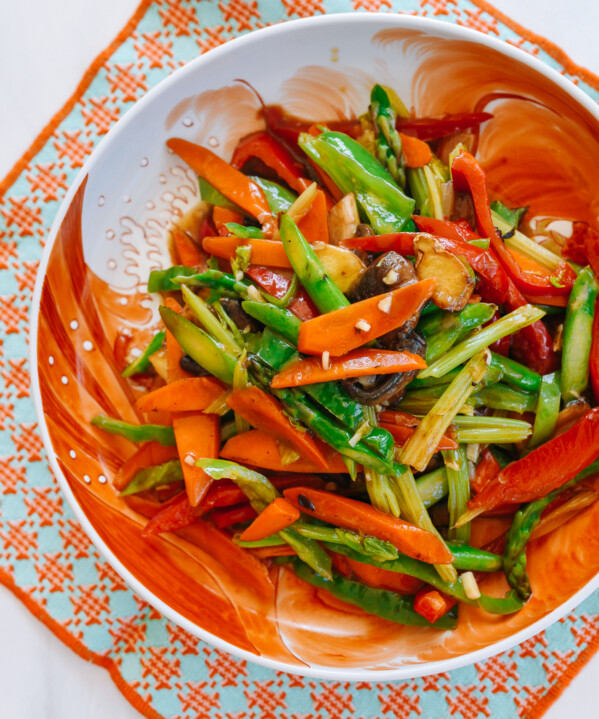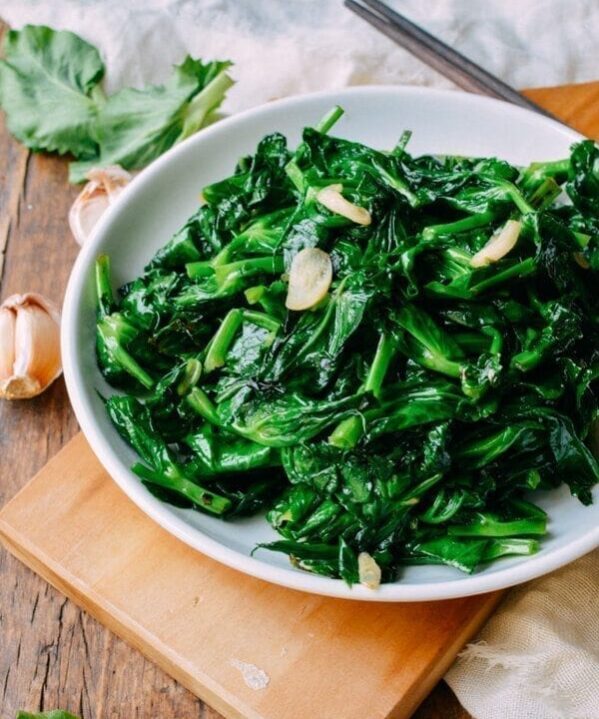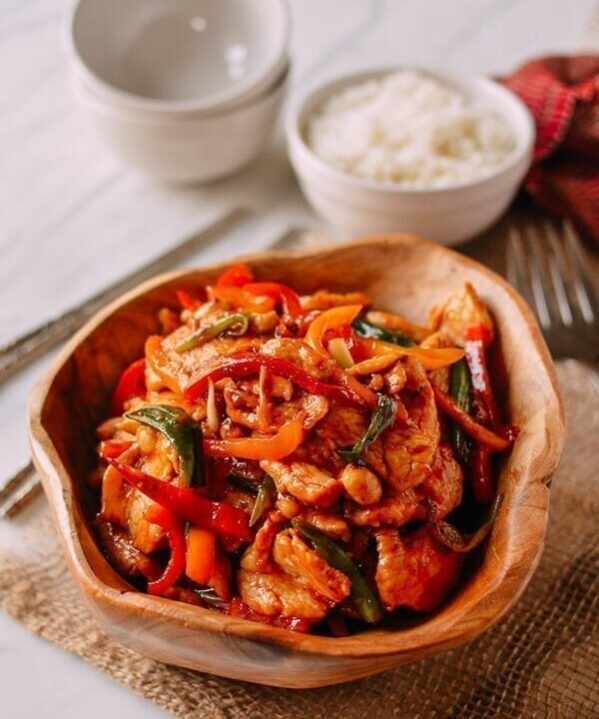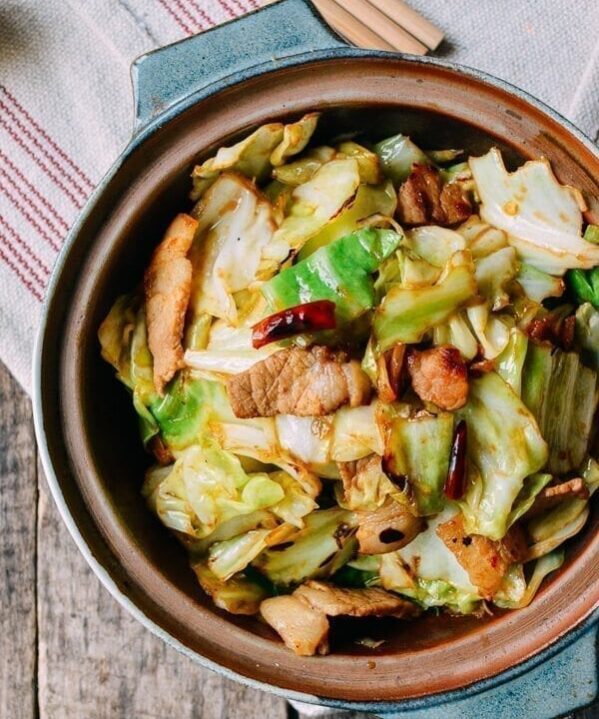This is an easy stir-fry sauce recipe to quickly make homemade stir-fries with whatever meat or vegetables you have!
Of all the recipes here on the Woks of Life, you may find yourself coming back to this one the most often for both versatility AND taste.
Over the years working and cooking in Chinese restaurants, I’ve made plenty of dishes cooked in a Chinese brown sauce. Every day, I would make dishes like beef and broccoli, chicken with string beans, and beef with mushrooms.
We even made dishes like moo goo gai pan and chicken with bean sprouts (traditionally made in a white sauce) “with brown sauce” upon request. So often, that rich dark sauce was the first choice of hungry customers, and for good reason. It’s TASTY. That said, we also have an All-purpose Chinese stir-fry white sauce recipe also!
The Ultimate Meal Prep
When hungry walk-ins are expecting their orders in ten minutes or less, it’s good to have an arsenal of shortcuts to make the process easier. One such shortcut was having an all-purpose brown sauce on hand to use as a base for many dishes, including the ever-popular Beef and Broccoli.
This ensured that anyone working at the wok station would make the same great-tasting dishes every single time. Consistency and speed are two very important requirements for a good Chinese restaurant, after all.
What was convenient at the restaurant extends to convenience at home. When Judy and I were both young, working, and taking care of our two young daughters, I used to slice vegetables and meats on the weekends or evenings, and portion out dishes two or three at a time to have them in the fridge ready to go.
With Judy picking up the kids from their after school program on the way home from her job in New York City, I would get home from work, start the rice cooker, unwrap the sliced meat and chopped vegetables, open up my homemade stir-fry sauce, and I was ready to wok! After just ten minutes in front of the stove, a stress-free dinner was on the table on time, with the rest of the evening to ourselves.
What Is In Our Stir-Fry Sauce Recipe?
Chinese brown sauce gets its name from the color of soy sauce and especially dark soy sauce, the ingredient that gives it that rich amber color.
Everything you need to make this sauce is listed in our post on 10 essential Chinese pantry ingredients. In fact, with those ingredients, you can make the vast majority of the recipes on our site!
This sauce includes (from left to right):
- Chicken stock
- Shaoxing wine (can substitute a dry sherry cooking wine)
- Soy sauce
- Sugar
- Oyster Sauce
- Dark Soy Sauce
- Sesame Oil
- White Pepper
- Salt (not pictured)
Depending upon your tastes, you may prefer to add some hoisin sauce, rice vinegar or some homemade chili oil to yours. You can perfect it to your own taste, which is the beauty of cooking at home.
Scroll down to the recipe card for the amounts/full recipe, as well as instructions on how to use this sauce with any meat/vegetables you like.
Can I Make Vegetarian/Vegan/Gluten-Free Stir-fry Sauce?
The short answer is: yes!
To make vegetarian/vegan stir-fry sauce:
- Substitute vegetable or mushroom stock for the chicken stock.
- Substitute vegetarian oyster sauce for the oyster sauce (vegetarian oyster sauce is made from mushrooms).
To make gluten-free stir-fry sauce:
- Use gluten-free soy sauce or tamari.
- The dark soy sauce is in the recipe mainly for color, so simply omit it. The color won’t be quite as brown, but it’ll still have good flavor.
- Use a gluten-free oyster sauce. Lee Kum Kee brand makes one that we use for gluten-free cooking!
What Can You Cook With It?
You can cook just about any meat and vegetable stir-fry dish with this basic sauce.
I used to make fridge clean-out stir-fry dishes every Friday with odds and ends left from the week with whatever protein we had available in our freezer, like beef, chicken, pork, or shrimp.
Whether you have carrots, peppers, onions, celery, snow peas, snap peas, bean sprouts, bok choy, etc. left over or readily available in your fridge, you can use any combination you like. Scroll down to the recipe card for the full ingredients list and recipe!
How to Use This Stir-fry Sauce:
1. Marinate Your Protein:
Marinate 12 ounces of sliced beef, chicken or pork with:
- 2 tablespoons water
- A pinch or more of baking soda (for beef only)
- 1 tablespoon oyster sauce
- 1 teaspoon vegetable oil
- 1 teaspoon cornstarch
Let the meat sit for at least 20 minutes. For more information on preparing and velveting meats for stir fry see:
How to Velvet Chicken for Stir-fry
How to Prepare Beef for Stir-fry
How to Velvet Pork for Stir-fry
How to Prepare Shrimp for Chinese Cooking
2. Prepare Aromatics:
I like to cut my aromatics fresh, so I will mince 3 cloves of garlic, grate a teaspoon of ginger, and perhaps slice 1 or 2 scallions into 2-inch lengths if I have some.
3. Slice Vegetables:
I’ll prepare the vegetables ahead of time, slicing celery, carrots, bell peppers, snow peas, onions, mushrooms, zucchini, eggplant, and/or broccoli. Use whatever you like and make sure to cut the vegetables small/thinly enough so that they’ll cook quickly (i.e. a couple of minutes).
4. Prepare Your Thickener:
2 tablespoons water mixed with 2 tablespoons cornstarch.
5. Sear Meat:
Add 2 tablespoons of vegetable oil to your hot wok (it should be almost smoking). Add the meat, sear on both sides, and set aside.
6. Assemble Stir-fry
Add another tablespoon of oil and add the garlic and ginger. (If you also sliced scallions, you can add the white parts of the scallion at this stage.)
After a few seconds, add the vegetables and stir fry for 1 minute or until just softened.
Add about 2/3 cup of stir fry sauce (more or less depending on how much sauce you like), and heat until simmering…
And add in the seared meat.
Bring to a boil and stir in the cornstarch slurry until the sauce is thick enough to coat a spoon (you may need a little more or a little less cornstarch slurry depending on how much sauce you added and how high your heat is). Add the green parts of your scallions (if using), and cook for another 15 to 20 seconds.
For more detailed information on the many ways to use cornstarch to get authentic results at home with our recipes, see our post on How to Use Cornstarch in Chinese Cooking.
Serve over rice!
We did a beef and mixed vegetable stir-fry as the example in these photos, but there are endless ways to use this method. Let us know your thoughts and ideas in the comments below!
Chinese Stir-Fry Sauce
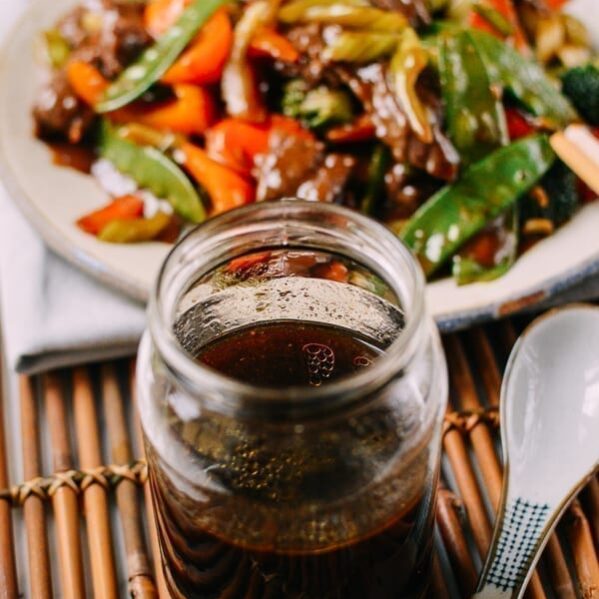
Ingredients
- 1 1/2 cups chicken stock (or vegetable or mushroom stock; 350ml)
- 1 tablespoon Shaoxing wine
- 1 tablespoon brown sugar (or granulated sugar)
- 2 teaspoons sesame oil
- 1/4 cup soy sauce (can sub gluten-free soy sauce or tamari)
- 1 1/2 tablespoons dark soy sauce
- 2 tablespoons oyster sauce (or vegetarian or gluten-free oyster sauce)
- 1/4 teaspoon white pepper
- 1/4 teaspoon salt
Instructions
- In a jar with a tight lid (must hold 2 cups of liquid), combine all of the stir fry sauce ingredients together and shake well.
- This sauce should keep for a few weeks in the refrigerator; all you need to do is measure and pour out what you need for your dish.
Tips & Notes:
nutrition facts
